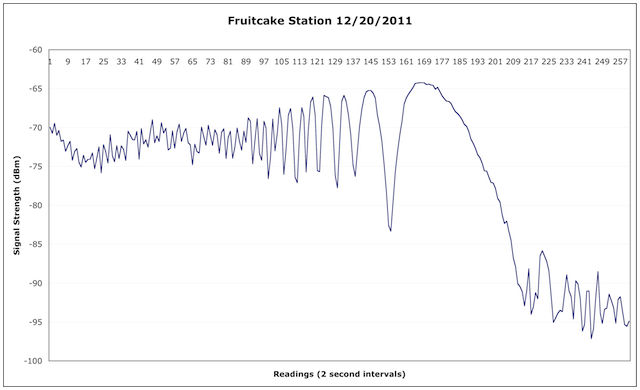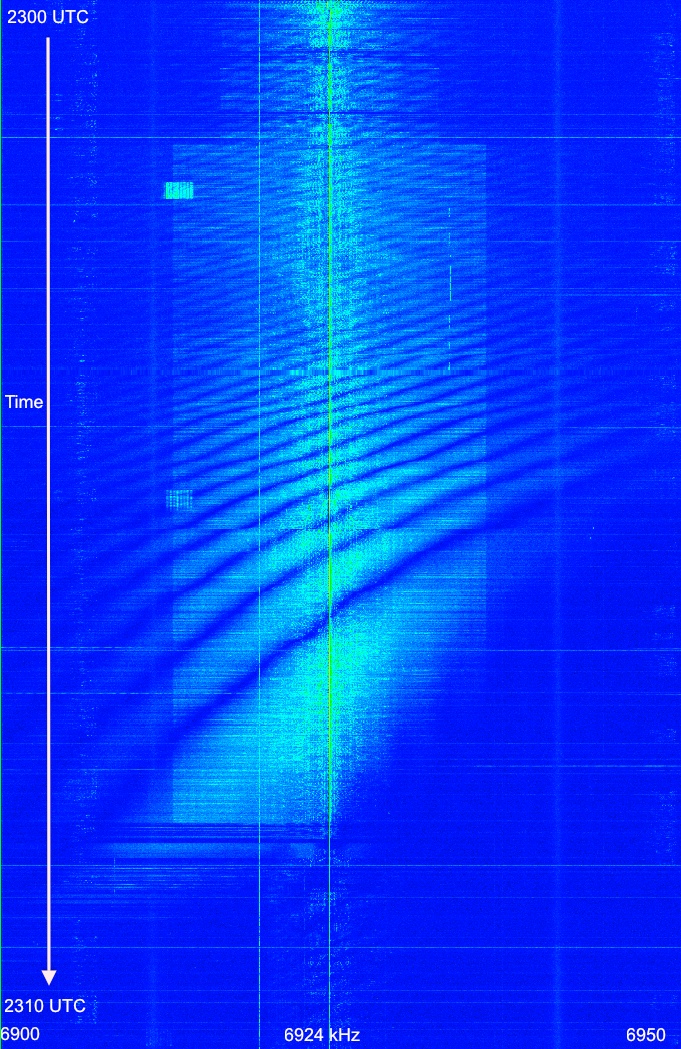A fairly active pirate station the past week or so has been the “Fruitcake” station, which plays songs and sound clips related to, well, fruitcake. Hence the name. On December 20, 2011 at 2300 UTC I recorded a transmission of this station with my netSDR. What I ended up capturing was a very interesting and educational example of a station going long.
Here is a graph of the received signal strength:

An S9 signal is -73 dBm, right about the received signal level at the beginning of the broadcast. There is some fading up and down, typical with shortwave radio. What’s interesting is that the change in signal strength seems to have a definite period, rising and falling every few seconds. After a few minutes, the period starts to become longer, and the amplitude of the variation also increases. About half way through the transmission, the amplitude becomes quite large. There is then one deep fade, one large increase in signal strength, and then the signal almost fades out, going down to about -95 dBm (about S4). Notice that 10 minutes ago it was S9.
Next, here is a waterfall of the recorded transmission:

A waterfall is a color coded representation of the signal strength of a band of frequencies over time. In this case, it shows us the signal strength from about 2300 to 2310 UTC, over a frequency range of 6900 to 6950 kHz. The blue background represents the weak background noise that is always present, in this case about -97 dBm. The brighter colors towards green represent stronger signals. We can see the station’s carrier at 6924 kHz, and the sidebands containing the audio modulation (this is an AM signal).
The change in bandwidth of the received signal about a minute and a half into the transmission is due to the audio that was transmitted, one song ended, and another sound clip, with wider audio, began.
This is an extremely educational image. We can see several things happening here:
1. The short choppy fades at the beginning of the transmission are evident.
2. As time goes on, the fades become more prominent, and we can see the increase in their period.
3. We can see the background noise levels increasing in amplitude. Look just outside the passband of the station itself, and you can see waves of increasing and decreasing background noise.
4. The fades all start at a higher frequency, and drift down to lower frequencies over time. This is a type of phenomena called selective fading, which you may have read about.
So, what is the cause of the selective fading? There are several possibilities.
One is when both ground wave and sky wave signals are being received. If there are phase differences between the two signals, they cancel out, reducing the received signal strength. Likewise, if they are in phase, they support each other, and add together, increasing the signal strength. One common example of this is with medium wave (AM broadcast) stations. When you are close to the station, the ground wave signal is extremely strong, and the sky wave is relatively weak, resulting in excellent reception with no fading. At a long distance away from the station, the ground wave is extremely weak or nonexistent, resulting in only a sky wave. Reception is weaker than the first example, but often reliable for stronger stations. This is why you can pick up AM stations over long distances at night. However, if you are at an intermediate distance, you can receive both the sky wave and ground wave. As the relative phase between them changes, you get fades. I’ve noticed this with a semi-local AM station. It has excellent reception in the daytime, but once evening approaches, reception gets very choppy. This is even before other stations begin to roll in.
I don’t think this is the cause in this case, as there should be little or no ground wave. And if there was, I would still be able to pick up the station after the band went long, since the ground wave was present. (Being HF instead of MW, the ground wave does not travel very far anyway)
Another possibility is due to propagation via both the E and F layers. In this case, it is again relative phase differences that cause the fading. I’m not sold on this scenario either, because I don’t believe the E layer would support propagation of 7 MHz signals. (E layer propagation should not be confused with sporadic E layer propagation that often causes VHF skip)
Next up, and the idea I am presently sold on, is propagation via both the F1 and F2 layers. During the daytime, when ionization is strongest, the F layer splits into two layers, the F1 at about 150-220 km and the F2 at 220-800 km. At night, the F1 layer merges with the F2 layer.
Perhaps, during the daytime, only one layer is responsible for NVIS propagation. My thought is that the F1 layer is providing the propagation, as it is the lower layer, and the first one the radio waves would interact with. Then, in the evening, when the band is going long and the F1 layer starts to dissipate allowing some radio waves to reach the F2 layer, propagation is occurring via both layers. Relative phase differences between the signals propagated by each layer cause the selective fading effects. Once the F1 layer completely dissipates, only the F2 layer is left, but it is unable to support NVIS propagation at 7 MHz.
Comments welcome and appreciated!

Super interesting, thanks for taking the time to write the article. Understanding signal propagation is the key to understanding what is happening on your shortwave radio, at which I’m a relative beginner.
I’m following your F1, F2 phasing hypothesis as an explanation of selective fading in the case of an NVIS antenna broadcast to a several hundred mile radius. But I’m wondering about selective fading on a broadcast from a long way away, say Argentina to North America where I figure one ionosphere layer would effectively do most of the propagation yet there is still selective fading.
Perhaps selective fading is also due to the phase difference between several signals, possibly due to multipath (the signal taking two or more paths between the transmitter and receiver sites)?